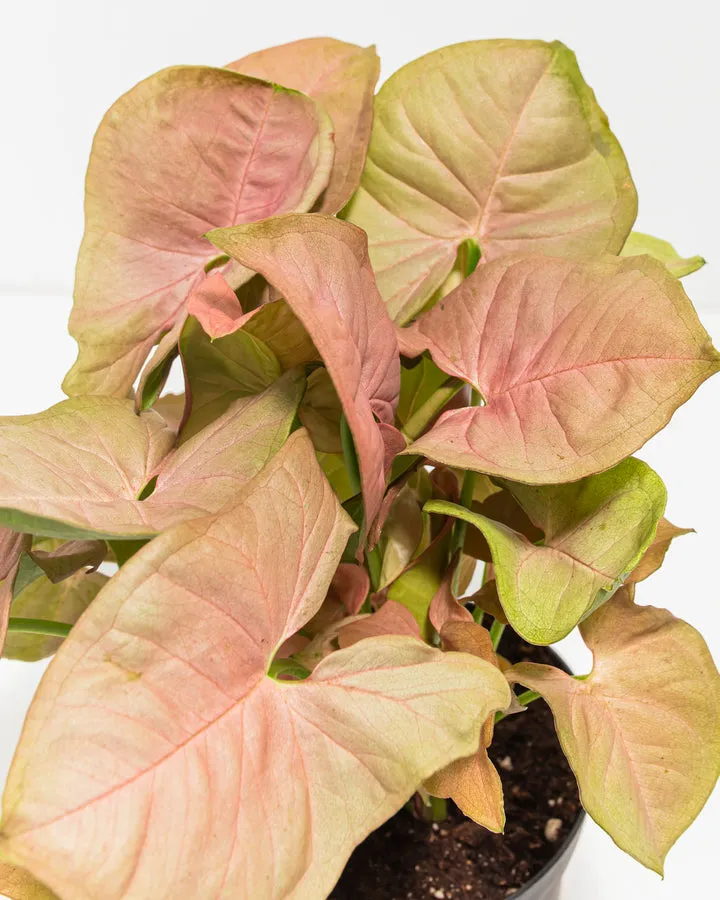Syngonium Care
Native to South America, Syngonium podophyllum is commonly called arrowhead vine and is a tropical evergreen climbing vine that typically grows high. A plant with different amounts of variegation, from entirely green to near white. It is also commonly known under the name Nephthytis podophyllum. Genus name comes from the Greek words syn meaning together and gone meaning reproduction and it is an epithet which specifically means with stout-stalked leaves. It is an easy-to-care plant and does best if left relatively alone, making it a great pick for novice gardeners or those who just don’t have so much time to garden frequently. Tropical in nature, Syngonium is perfect for places where ample heat, light, and humidity will encourage their growth. Provide your plant with the right growing conditions, and you will have a lush and healthy plant.

How to care for your Syngonium
- LIGHT
Syngonium is low light tolerant, however, it will grow faster and maintain its vibrant coloring and markings if grown in medium to bright indirect light. It doesn’t like to be exposed to direct sunlight as its leaves will start to scorch.
You can place the Syngonium in any position as long as it receives good light and is not touched by direct sunlight. For an optimal environment for your Syngonium, place it in rooms with south-facing windows, but keep them out of direct sunlight.
- WATER
Syngonium is quite a thirsty houseplant, especially if it’s in a small container or pot. The frequency of watering depends on how old the plant is such that younger plants require much less water, but bigger plants will need much more frequent watering, potentially several times a week if the temperature is very warm. Moreover, make sure the soil is evenly moist after you have watered your plant. Let the soil dry between waterings and let it dry for a longer period of time during winter as the plant itself will take longer to dry out.
- HUMIDITY
Syngonium plants prefer higher humidity levels, ideally between 50-70%. While they can adapt to average household humidity, providing additional moisture can enhance their growth and overall health. Consider placing a humidifier nearby, misting the leaves regularly, or positioning the plant in a more humid environment, such as a bathroom or kitchen.
- TEMPERATURE
Syngonium plants thrive in temperatures between 65°F and 80°F (18°C to 27°C). They are sensitive to cold drafts and extreme temperature fluctuations, so it’s essential to keep them in a stable environment. Avoid placing them near air conditioning vents or drafty windows, as exposure to temperatures below 50°F (10°C) can cause stress and hinder growth.
- FOOD
Syngonium plants thrive with regular feeding during their growing season, typically in spring and summer. Use a balanced liquid fertilizer diluted to half strength every 4-6 weeks. This provides the essential nutrients they need for vibrant growth and lush foliage. In the fall and winter, reduce feeding as the plant enters a dormant phase and growth slows down.
- TOXICITY
Syngonium plants contain calcium oxalate crystals, which can be toxic to pets and humans if ingested. Symptoms of ingestion may include mouth and throat irritation, swelling, and difficulty swallowing. It’s essential to keep the plant out of reach of pets and children. If ingestion occurs, seek medical attention or contact a veterinarian immediately.
- ADDITIONAL CARE
For optimal growth, regularly check the soil moisture and allow the top inch to dry out before watering. Syngonium plants benefit from occasional pruning to maintain their shape and promote bushier growth. Ensure the plant is in well-draining soil and consider repotting every couple of years to refresh the soil and allow for growth. Monitor for common pests, like spider mites and aphids, and treat with insecticidal soap if necessary.
Common Issues for your Syngonium
The main cause of yellowing leaves among Syngonium (Arrowhead) plants is improper soil moisture, more precisely, overwatering.
Solution: To prevent your plant from turning yellow, water it only when the top 50% of the soil in the pot is dry. When giving your plant a drink, make sure you provide enough water so that liquid flows from the drainage hole at the bottom of the pot and into the saucer. Do not let your plant sit in any excess water that has accumulated in the saucer and make sure you discharge any excess as it does not respond well to “wet feet,” which will cause the roots to rot and lead to the eventual death of the plant. Yellow leaves are the first sign that root rot may be occurring.
The humidity level around the plant may also be a potential cause of yellow foliage. Low humidity causes leaves to droop and brown on their edges, later followed by yellowing and even full browning, and shriveling.
Solution: Boost the levels of humidity by regularly misting the Syngonium or use a humidifier or pebble tray.
Dark brown spots on your Syngonium may signal the presence of bacteria. Bacterial blight and stem rot are caused by the bacteria Erwinia with symptoms including dark green spots on the leaves and a foul-smelling soft rot.
Solution: The first thing you can do is to move the infected plant away from any other healthy plants to make sure they stay healthy and disease-free. Second, try to avoid wetting the foliage and consider treating the plant with a bactericide to help prevent infection.
